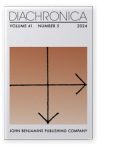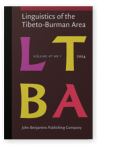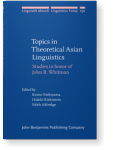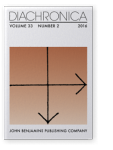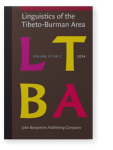Pittayawat Pittayaporn
List of John Benjamins publications for which Pittayawat Pittayaporn plays a role.
Journal
2024 Revisiting “aberrant” features in Saek: Contact-induced changes and its position within Tai Linguistics of the Tibeto-Burman Area 47:1, pp. 90–117 | Article
This study challenges the notion of Saek as an aberrant member of Tai by proposing that certain features previously considered archaic are, in fact, contact-induced innovations. Specifically, it argues that multiple correspondences involving /j-/ and the alleged split of the Proto-Tai *A1 tone… read more
2018 Chapter 17. Quantitative and qualitative restrictions on the distribution of lexical tones in Thai: A diachronic study Topics in Theoretical Asian Linguistics: Studies in honor of John B. Whitman, Nishiyama, Kunio, Hideki Kishimoto and Edith Aldridge (eds.), pp. 371–386 | Chapter
In present-day Thai, contour tones show a more restricted distribution in comparison with level tones that cannot be explained by syllable structure alone. This diachronic study argues that both quantitative and qualitative restrictions are responsible for the puzzling gaps and accounts for them by… read more
2016 Chindamani and reconstruction of Thai tones in the 17th century Diachronica 33:2, pp. 187–219 | Article
Chindamani, the oldest surviving text about the Thai language, contains a direct but equivocal description of Thai orthography and prosody. Combining careful textual study with findings and analytical tools from Comparative Tai, I argue that 17th century Thai had already established a… read more
2014 Reconstruction of Proto-Tai negators Linguistics of the Tibeto-Burman Area 37:2, pp. 151–180 | Article
Based on comparative data from 64 modern Tai varieties, we propose that Proto-Tai had three distinct negators, namely *ɓawB, *mi and *pajB. These morphemes were distinguished from each other in terms of aspect. Moreover, we show that the Old Thai language represented by the literary classic Lilit… read more
2012 Phonologically-constrained change: The role of the foot in monosyllabization and rhythmic shifts in Mainland Southeast Asia Diachronica 29:4, pp. 411–433 | Article
Changes in word shapes in Mainland Southeast Asia are usually attributed to contact-induced typological convergence. However, little attention has been paid to the role of structural constraints in defining paths of change. In this paper, we describe two distributional gaps in paths of word shape… read more
Information structure and changes in Moklen word-form Asia-Pacific Language Variation: Online-First Articles | Article
In this study, we investigate an apparent discourse-based alternation between monosyllabic and disyllabic word-forms in Moklen, an Austronesian language spoken in Thailand. We explore whether factors of information structure condition the variable elision of the first syllable of certain… read more
